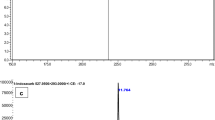Abstract
Indoxacarb residues were estimated by employing standardized QuEChERS technique in cabbage following three applications of AvantR 14.8 EC @ 52.2 and 104.4 g a.i. ha−1. The average recoveries of indoxacarb on cabbage for fortification levels of 0.01, 0.05 and 0.1 mg kg−1 were observed to be 83.93, 89.86 and 95.40%, respectively, with relative standard deviation of 1.21, 1.53 and 2.23. The method was also validated with respect to parameters of linearity, precision and limit of quantification (LOQ). The LOQ for cabbage was found to be 0.01 mg kg−1. The average initial deposits of indoxacarb on cabbage were observed to be 0.18 and 0.39 mg kg−1, respectively, at single and double the application rate. These indoxacarb residues dissipated below its LOQ of 0.01 mg kg−1after 7 and 10 days, respectively, at single and double dosages. Half-life of indoxacarb was observed to be 2.88 and 1.92 days, respectively, at recommended and double the recommended dosages.



Similar content being viewed by others
References
Allen CT, Kharboutli MS, Capp C Jr, Eearnest L (1999) Steward™: new insecticides for the new millennium special report 193. Arkansas Agricultural experiment Station, University of Arkansas, Fayetteville, pp 56–64
Anonymous (1998) Avaunt ™, insect control agent. Technical bulletin H-79164. Du Pont, Wilmington
Anonymous (2008) Package of practice for vegetable crops. Punjab Agricultural University, Ludhiana, pp 92–110
Anonymous (2009a) www.indiastat.com. Accessed on 16 July 2010
Anonymous (2009b) Guide to codex maximum limits for pesticide residues. Food and Agricultural Organization, Rome
Bassi A, Cunsolo D, May L, Parente L, Turchiarelli V, Massasso W, Sandroni D (2000) DPX-MP062 (Steward™) a new insecticide for IPM in vegetable crops. Efficacy results on Lepidoptera in pepper, tomato, cauliflower and cabbage crops. In: Atti, Giornate Fitopatologiche, Perugia, 16–20 April 2000 (Bologna: Universita degli studi di Bologna), pp 515–520
Gill CK, Kaur S, Joia BS (2008) Efficacy of new insecticides for the management of diamondback moth, Plutella xylostella (Linnaeus) on cauliflower and cabbage. J Insect Sci 21:171–177
Gupta S, Sharma RK, Gupta RK, Sinha SR, Gajbhiye VT (2009) Persistence of a new insecticides and their efficacy against insect pests of okra. Bull Environ Contam Toxicol 82:243–247
Harder HH, Riley SL, McCann SF, Irving SN (1997) DPX-MPO62: a novel broad spectrum, environmentally soft, insect control compound. In: Dugger P, Richter D (eds) Proceedings of beltwide cotton conferences, New Orieans, 6–10 Jan 1997, pp 48–50. National Cotton Council, Memphis
Holloway J, Forrester N (1998) New insecticide chemistry for Australian cotton IPM. Aust Cotton Grow 19:29–34
Hoskins WM (1961) Mathematical treatments of loss of pesticide residues. FAO Plant Prot Bull 9:163–168
Lahm GP, McCann SF, Harrison CR, Stevenson TM, Shapiro R (2000) Evolution of the sodium channel blocking insecticides: the discovery of indoxacarb. agrochemical discovery, Chap 3, pp 20–34
Liu TX, Sparks AN Jr (1999) Efficacies of some selected insecticides on diamondback moth and diamondback moth on cabbage in South Texas. Subtrop Pl Sci 51:54–58
Liu TX, Sparks AN Jr, Chen W, Liang GM, Brister C (2002) Toxicity, persistence and efficacy of indoxacarb on cabbage looper (Lepidoptera: Noctuidae) on cabbage. J Econ Entomol 92:360–367
Mc Cann SF, Annis GA, Shapiro R, Piotrowski DW, Lahm G, Long JK, Lee KC, Hughes MM, Myers BJ, Griswold SM, Reeves BM, March RW, Sharpe PL, Lowder P, Barnette WE, Wing KD (2001) The discovery of indoxacarb: oxadiazines as a new class of pyrazzoline-type insecticides. Pest Manag Sci 57:153–164
Murthy MS, Jagdish PS, Sannaveerappananvar VT (2006) Efficacy of plant products and new insecticides against diamondback moth, Plutella xylostella (L.) (Yponomeutidae: Lepidoptera) on cabbage. J Pl Protec Environ 392:1–5
Olszak RW, Pluciennik Z (1999) Leaf roller (Tortricidae) and fruit moth (Laspeyresia funebrana and cydia pomonella) control with modern insecticides. In: Proceedings of the 5th international conference on pests in agriculture, Part 2, Montpellier, 7–9 Dec 1999, pp 311–318. Association Nationale pour la Protection des Plantes, Paris
Patel BA, Shah MF, Patel BK, Patel JL, Talati JG (1999) Chlorpyriphos residues in/on cabbage and brinjal. Pestic Res J 11(2):194–196
Pluschkellm U, Horowitz AR, Weintraub PG, Ishaaya I (1998) DPX-MPP062—a potent compound for controlling the Egyptian cotton leafworm Spodoptera littoralis (Boisd). Pestic Sci 54:85–90
Regupathy A, Habcebullah B, Balasubramanian M (1985) Dissipation of insecticides applied to control Plutella xyllostella citrus and spodoptera litura, faber in cabbage. Pesticides 19(9):53–56
Singh S, Choudhary DP, Mathure YS (2005a) Efficacy of some newer insecticides against against fruit borer, Helicoverpa armigera (Hubner) on tomato. Indian J Entomol 67(4):339–341
Singh V, Thakur BS, Chandraker MK (2005b) Bio-efficacay of insecticides against insect pests of chilli. Environ Ecol 23S(Special 3):600–604
Sinha SR, Gupta RK, Gajbhiye VT, Nath V (2010) Bioefficacy and persistence of indoxacarb on Solanum melongena. Ann Pl Protec Sci 18(1):223–282
Wing KD, Schnee ME, Sacher M, Connair M (1998) A novel oxadiazine insecticide is bioactivated in lepidopteran larvae. Arch Insect Biochem Physiol 37:91–103
Author information
Authors and Affiliations
Corresponding author
Rights and permissions
About this article
Cite this article
Urvashi, Jyot, G., Sahoo, S.K. et al. Estimation of Indoxacarb Residues by QuEChERS Technique and Its Degradation Pattern in Cabbage. Bull Environ Contam Toxicol 88, 372–376 (2012). https://doi.org/10.1007/s00128-011-0468-8
Received:
Accepted:
Published:
Issue Date:
DOI: https://doi.org/10.1007/s00128-011-0468-8




